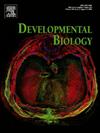Drosophila grainyhead gene and its neural stem cell specific enhancers show epigenetic synchrony in the cells of the central nervous system
IF 2.5
3区 生物学
Q2 DEVELOPMENTAL BIOLOGY
引用次数: 0
Abstract
Enhancers are the epicentres of tissue-specific gene regulation. In this study, we have used the central nervous system (CNS) specific expression of the Drosophila grainyhead (grh) gene to make a case for deleting the enhancers in a sensitised background of other enhancer deletion, to functionally validate their role in tissue-specific gene regulation. We identified novel enhancers for grh and subsequently deleted two of them, to establish their collective importance in regulating grh expression in CNS. This showed that grh relies on multiple enhancers for its robust expression in neural stem cells (NSCs), with different combinations of enhancers playing a critical role in regulating its expression in various subset of these cells. We also found that these enhancers and the grh gene show epigenetic synchrony across the three cell types (NSCs, intermediate progenitors and neurons) of the developing CNS; and grh is not transcribed in intermediate progenitor cells, which inherits the Grh protein from the NSCs. We propose that this could be a general mechanism for regulating the expression of cell fate determinant protein in intermediate progenitor cells. Lastly, our results underline that enhancer redundancy results in phenotypic robustness in grh gene expression, which seems to be a consequence of the cumulative activity of multiple enhancers.

求助全文
约1分钟内获得全文
求助全文
来源期刊

Developmental biology
生物-发育生物学
CiteScore
5.30
自引率
3.70%
发文量
182
审稿时长
1.5 months
期刊介绍:
Developmental Biology (DB) publishes original research on mechanisms of development, differentiation, and growth in animals and plants at the molecular, cellular, genetic and evolutionary levels. Areas of particular emphasis include transcriptional control mechanisms, embryonic patterning, cell-cell interactions, growth factors and signal transduction, and regulatory hierarchies in developing plants and animals.
 求助内容:
求助内容: 应助结果提醒方式:
应助结果提醒方式:


